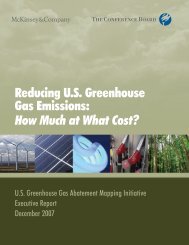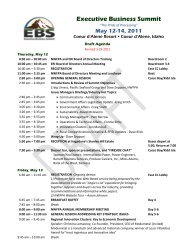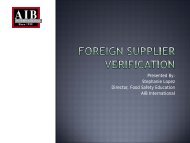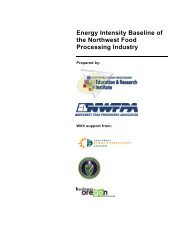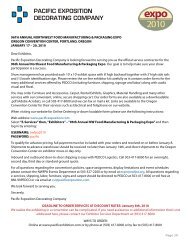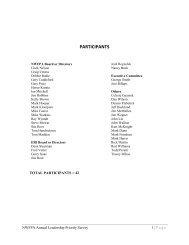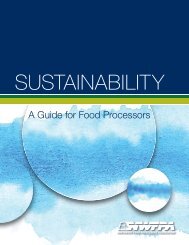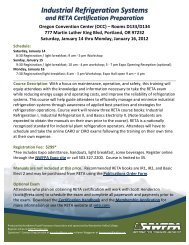Download
Download
Download
You also want an ePaper? Increase the reach of your titles
YUMPU automatically turns print PDFs into web optimized ePapers that Google loves.
BRC Global Standard for<br />
Food<br />
2012 Update<br />
John Kukoly<br />
BRC Global Standards
BRC and GFSI<br />
• Benchmarking for issue 6 underway<br />
• Benchmarking for Packaging underway<br />
• Benchmarking document for Storage and<br />
Distribution being developed by GFSI<br />
working group (2012 benchmarking<br />
expected)
Current Position for BRC<br />
• 14,157 Certificated sites<br />
Year on Year growth of 21%<br />
• Certificates issued in 115 Countries<br />
• 103 Certification Bodies<br />
• 1511 BRC registered auditors
Issue 6 - Feedback<br />
• Produce a Standard which really reduces<br />
duplicate customer audits<br />
• Improve the balance between time spent in<br />
the office and time in the factory<br />
• Review the audit report to ensure this adds<br />
value but not cost<br />
• Improve the consistency between auditors<br />
• Provide a way to recognize and track sites in<br />
development
Publication<br />
• Issue 6 publication date<br />
29 th July 2011<br />
• Translations from<br />
September 2011<br />
• Interpretation Guideline<br />
early 2012
New for Issue 6<br />
• Re- focus of the audit process<br />
– Consistency and priorities<br />
• An evolution of requirements<br />
– Emerging issues and transparency<br />
• Introduction of more choice of audits<br />
– Facilitate voluntary unannounced audits<br />
• Enrolment scheme<br />
– Encouraging adoption of food safety
The 2 part audit<br />
FUNDAMENTAL<br />
The company shall be able to trace all raw material product lots (including packaging) from<br />
their supplier through all stages of processing and despatch to their customer and vice versa.<br />
Clause<br />
Requirements<br />
3.9.1 Identification of raw materials, including primary and any other relevant packaging and<br />
processing aids, intermediate/semi-processed products, part-used materials, finished<br />
products and materials pending investigation, shall be adequate to ensure traceability.<br />
3.9.2 The company shall test the traceability system across the range of product groups to<br />
ensure traceability can be determined from raw material to finished product and vice versa,<br />
including quantity check/mass balance. This shall occur at a predetermined frequency and<br />
results shall be retained for inspection. The test shall take place at least annually. Full<br />
traceability should be achievable within four hours.<br />
3.9.3 Where rework or any reworking operation is performed, traceability shall be maintained.
6.3 Exclusion from Scope<br />
.<br />
Products<br />
must be<br />
produced in<br />
a separate<br />
area of the<br />
factory<br />
Products<br />
must be<br />
produced<br />
on different<br />
production<br />
equipment<br />
All<br />
exclusions<br />
must be<br />
agreed in<br />
advance<br />
Excluded<br />
products<br />
must not<br />
compromise<br />
the safety of<br />
those in<br />
scope<br />
Part of a<br />
process<br />
cannot be<br />
excluded
Increasing audit choices<br />
Enrolment<br />
Program<br />
Announced<br />
Unannounced<br />
Full Announced<br />
Audit<br />
Option 1<br />
• Full Unannounced<br />
Audit<br />
(Documentation<br />
and Factory)<br />
Option 2<br />
• Part 1<br />
Unannounced<br />
Audit (Factory)<br />
• Part 2 Announced<br />
(Documentation)
Enrolment scheme<br />
Objectives<br />
• Provide an entry point for sites<br />
developing food safety systems, with<br />
demonstrable improvements in safety<br />
• Allow all sites to be on the same road<br />
• Designed particularly for developing<br />
markets and very small suppliers<br />
• Clear differentiation between enrolled<br />
and certificated sites
Main changes to<br />
requirements<br />
• Extended requirements in key areas<br />
– Supplier and raw material controls<br />
– Foreign body control<br />
– Housekeeping and hygiene<br />
– Allergen management<br />
– Provenance/Assurance claims
Management Commitment<br />
- Review tied to proven business<br />
strategies; objectives, steering and<br />
operational oversight<br />
- Introduction of Root Cause Analysis
HACCP<br />
• Based on codex principles and largely unchanged,<br />
audit methodology strengthened through auditor<br />
training and re-calibration<br />
• Auditor challenge rather than system review<br />
• Focus on validation, international regulations<br />
• Emphasis given to the verification of the control<br />
points
Suppliers and raw materials<br />
Supplier Raw Material & Performance Monitoring<br />
Clause 3.5.1 Management of Suppliers of Raw<br />
Materials and Packaging<br />
Clause 3.5.2 Raw Material and Packaging<br />
Acceptance and Monitoring Procedure<br />
Clause 3.5.3 Management of Supplier of Services<br />
Clause 3.5.4 Management of Out Sourced Processing
Traceability<br />
• Standardized approach to auditing<br />
traceability by extending into a vertical<br />
audit of production records
Layout and product flow<br />
• Factory plan to define production<br />
zones<br />
– Enclosed product areas<br />
– Low risk areas<br />
– High care area<br />
– High risk area
High care/High risk<br />
• New decision tree and guideline to<br />
define high care/risk areas<br />
• High care to have similar requirements<br />
to current high risk<br />
– Dedicated changing facilities<br />
– Visually distinctive protective<br />
clothing<br />
– Physically segregated areas<br />
–Or equivalent controls
Increased emphasis on cleaning<br />
• Defined and validated levels of cleaning<br />
performance<br />
• Hygiene and fabrication audits included<br />
within internal audits, monthly<br />
• Focus on line change over risk<br />
management
Management of allergens<br />
• Requirements extended to address the<br />
issues identified through product<br />
recalls<br />
– More specific guidance on measures to<br />
avoid cross contamination<br />
– Line start up and product change checks<br />
– Allergen awareness training for staff<br />
– Increased consideration of allergen risks<br />
in new product development
Process control<br />
• Demonstrating the control of both<br />
product quality and safety<br />
–Process specifications<br />
–Line start up checks<br />
–Packaging checks at product<br />
change
Thank you<br />
.



